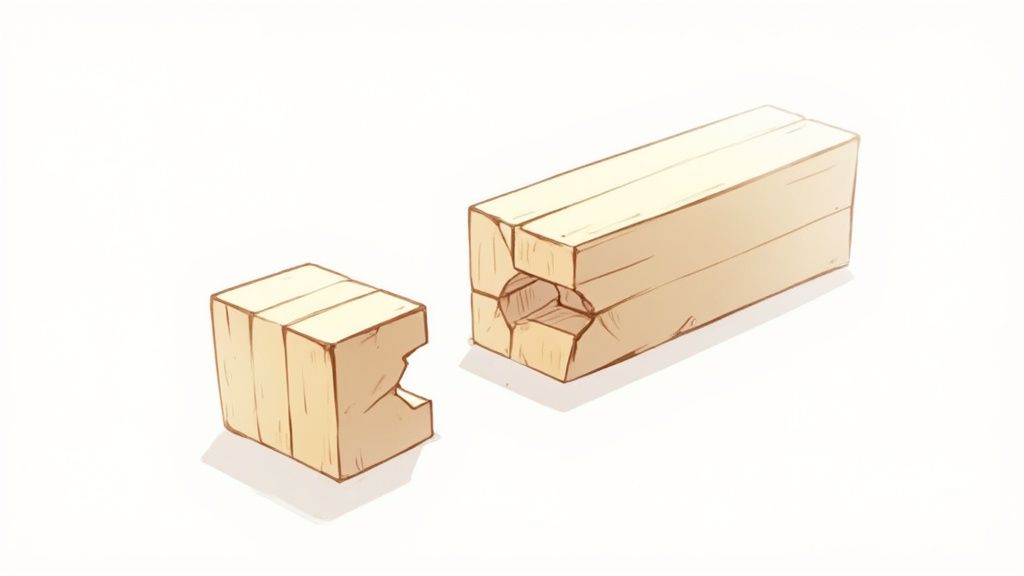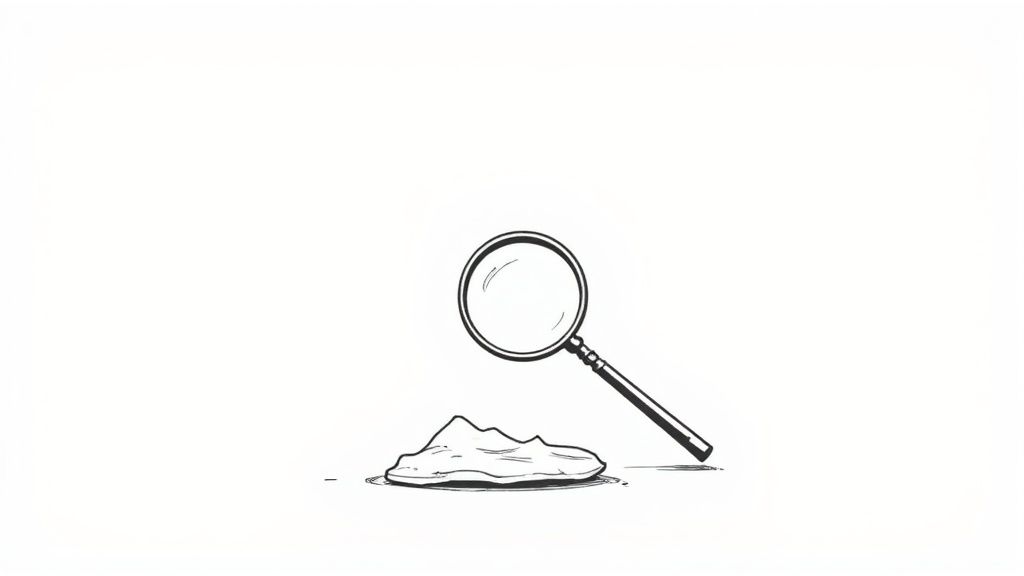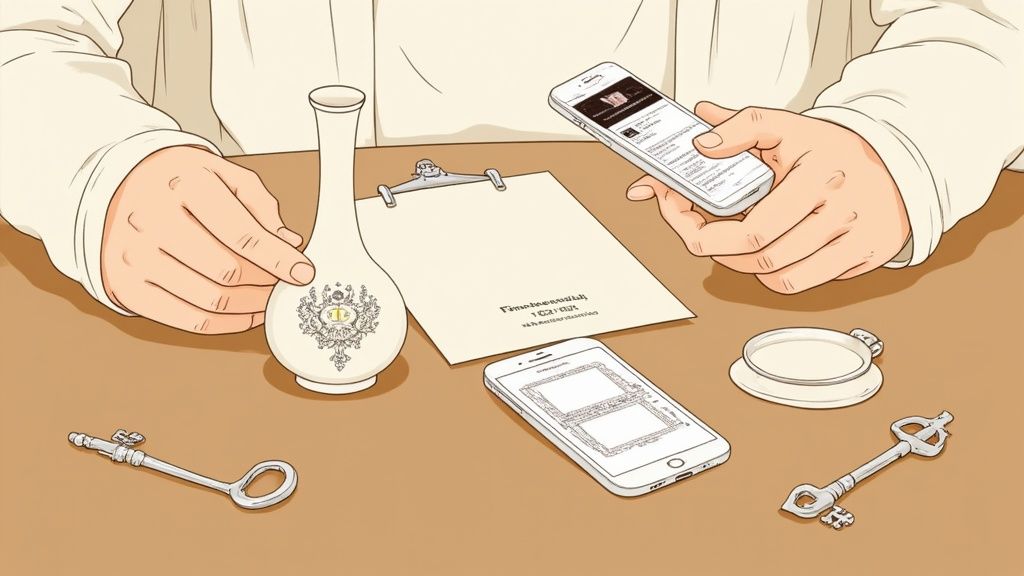To really figure out if you have a genuine antique on your hands, you need to get up close and personal. It’s about more than just what it looks like from a distance. A true hands-on inspection—feeling the weight, examining the materials, and looking for tell-tale signs of age like patina and wear—is where you start. These first observations are what separate the real deal from a convincing fake.
Your First Steps to Identify an Antique
The journey to uncovering an item's story begins the moment you lay hands on it. Don't worry about knowing everything right away. Instead, focus on training your eyes and hands to pick up on the subtle clues that only time can create. This is your core skill—the ability to do a quick, yet insightful, assessment that will point your research in the right direction.
This initial look is where you shift from a casual admirer to a focused investigator. Pay attention to how the object feels in your hands, its balance, and the way it was put together.
The Feel and Weight of an Object
One of the most reliable, yet often overlooked, clues is an item's weight. So many modern reproductions, especially furniture and metalwork, are made from cheaper, lighter materials to cut costs. An old piece of oak furniture, for example, will have a satisfying heft to it that you just don't get from a modern pine piece made to look old.
The same principle applies to smaller items. I once handled an antique mercury glass bead garland that was surprisingly light, almost ethereal. That delicate, feather-light quality is what allowed it to drape so elegantly, a feel completely different from the clunky, heavy plastic knock-offs you see today. This immediate tactile feedback is often your very first clue that you've got something special.
Looking for Signs of Authentic Age
Real age shows itself in ways that are incredibly hard to fake well. You're not looking for a piece that's just been artificially distressed; you're looking for honest evidence of a long and storied life.
- Patina: This is that soft, mellow sheen that develops on a surface after decades of use, cleaning, and exposure to the air. On wood, it’s a deep, warm glow. On metals like silver or bronze, it's a gentle darkening in the crevices. A real patina looks like it’s part of the material, not something just painted on top.
- Wear Patterns: Check for wear and tear in places that make sense. The handle of a favorite teacup, the arms of a chair, the corners of a well-traveled trunk—these spots should show the most use. The wear should look natural and uneven, not perfectly symmetrical.
- Imperfections: Remember, old-school manufacturing wasn't flawless. Hand-blown glass often has tiny trapped air bubbles or a rough pontil mark on the bottom where it was broken off the rod. Hand-painted pottery might have slight brushstroke variations. These "flaws" are often signs of authenticity.
The most convincing antiques are the ones that tell a consistent story. The materials used, the style of construction, the wear patterns, and any maker’s marks should all point to the same time and place. If one of these things feels off, that's a major red flag.
Quick Antique Identification Checklist
Before you dive deep into research, running through a quick physical checklist can save you a ton of time. This table summarizes the initial look-and-feel tests you should perform on any potential antique.
| Attribute to Check | What to Look For | What It Might Indicate |
|---|---|---|
| Weight & Balance | Does it feel unusually light or heavy for its size and material? | Modern reproductions often use cheaper, lighter materials. Genuine pieces feel substantial. |
| Surface Patina | A soft, warm sheen on wood; gentle, dark oxidation on metal. | Authentic aging from years of exposure and handling. Fake patina looks applied or painted on. |
| Wear & Tear | Wear in logical places (handles, feet, corners). Uneven, natural patterns. | A history of genuine use. Symmetrical, uniform wear suggests artificial distressing. |
| Construction | Hand-cut dovetails, pontil marks on glass, slight asymmetry. | Hand-craftsmanship from a pre-industrial era. Modern machine-made precision is a red flag. |
| Materials | Solid wood (not veneer on particleboard), old hardware, hand-forged nails. | Use of period-appropriate materials. Modern alloys or materials indicate a later production. |
Think of this checklist as your first pass. If an item ticks these boxes, it’s definitely worth investigating further.
It's worth remembering the official definition that underpins the entire market: an antique is generally considered to be an item that is at least 100 years old. This benchmark is more than just a number; it's the foundation of a robust global industry built on history and heritage. Collectors and investors treat these pieces as tangible assets, which helps sustain a market where value is tied directly to cultural significance. For those interested, you can find a deeper analysis of the global antiques market and its economic drivers.
Uncovering an Antique’s Signature: How to Decode Maker's Marks
Sometimes, the single most telling clue about an antique's past is tucked away in plain sight. A tiny stamp, a faint signature, a cryptic symbol—these are maker's marks, and they are your Rosetta Stone for identifying a piece. For an enthusiast, finding and deciphering one is one of the most exciting parts of the hunt.
Think of these marks as the fingerprints left behind by artisans, factories, and designers. They might be stamped, impressed into clay before firing, painted on, or delicately etched into a surface. The search itself is half the fun.
Where to Look for Maker’s Marks
Your first step is always a meticulous, hands-on inspection. The location of a mark usually depends on the object, so you need to know the common hiding spots. Be patient and check everywhere.
- Pottery & Porcelain: Almost always on the bottom. Flip it over and look for stamps, impressed marks in the clay, or hand-painted details on the unglazed foot rim.
- Silver & Metalware: Check the back of utensil handles, the inner lip of a bowl, or the underside of a tray. Silver hallmarks, in particular, are often a series of tiny, complex symbols in a row.
- Furniture: This requires some detective work. Check the back panel, underneath the top, inside drawers, or even look for a paper label glued in an out-of-the-way spot.
- Glassware: The base is your best bet. Marks are often acid-etched and can be incredibly faint. You might need to hold the piece up to a light source, tilting it back and forth to catch a glimpse.
Once you find a mark, a clear photograph is your most important tool for research. Use bright but indirect light to avoid glare, and get as close as you can without losing focus. That photo is your key to unlocking online databases and reference guides.
The image below gives you a sense of the sheer variety you might encounter on ceramics alone.

As you can see, some marks spell things out with words like "England" or use recognizable symbols like a crown. Others are purely abstract, which means you'll have to do a bit more digging to connect them to a maker.
What a Simple Mark Can Reveal
That moment of successful identification feels like a huge breakthrough. For instance, you might find a small, blue-stamped crown on the bottom of a teacup. After a bit of research, you discover it’s the mark for Allertons, an English bone china company. By comparing that specific crown style to examples in a hallmark guide, you could potentially narrow its production window down to a specific decade, say 1915-1920.
A maker's mark doesn't just name the creator. It can reveal the specific factory, a production period, and the country of origin, instantly turning a mystery item into a historical artifact with a real story.
Keep in mind that many companies changed their marks over the years. The addition of "Made in..." is a great clue, often indicating a piece was produced for export after 1921 to comply with U.S. tariff laws. Similarly, the term "Bone China" typically points to something made in the 20th century.
Learning these little rules of thumb helps you quickly place an item in its proper historical context. And, of course, knowing the maker is a crucial step toward valuation. To learn more about that side of things, read our guide on how to find the value of antiques. This knowledge elevates you from simply identifying an object to truly understanding its place in the market.
Analyzing Materials and Construction Methods

While a maker’s mark is a fantastic starting point, the real story of an antique is often told in how it was put together. You have to get your hands on the piece and look closely at the materials and construction. It’s like being a detective—the methods of the past left behind distinct fingerprints that are a world away from modern, mass-produced items.
This hands-on analysis is your secret weapon for dating an object, especially when there’s no signature to go by. It’s also your best defense against well-made reproductions that might look the part but fall apart on the structural details.
Clues Hidden in Construction
The biggest giveaways are almost always in the joinery. Before factories took over, artisans relied on incredible skill and hand tools, and their work has tell-tale signs. The classic example you'll see in old furniture is the dovetail joint.
- Hand-Cut Dovetails: Look for slight irregularities. The pins are often skinny and the tails are wider. You might even spot faint scribe lines where the woodworker marked their cuts. This was the go-to method before the late 19th century.
- Machine-Cut Dovetails: These are the opposite—perfectly uniform and evenly spaced. This machine precision is a dead giveaway for pieces made from about 1880 onwards.
Just learning to spot this one detail can instantly help you tell an 18th-century chest from a 20th-century one. If you want to go deeper into cabinetry and joinery, we have a complete guide on how to identify antique furniture.
Hardware is another goldmine of information. Hand-forged nails with their clunky, irregular heads were the norm until the early 1800s. After that came square-cut nails. The round wire nails we see everywhere today didn't become common until the turn of the 20th century.
The materials tell no lies. A piece of furniture can't be from 1780 if it's held together with Phillips head screws, which weren't commercially available until the 1930s. Every screw, nail, and joint adds a sentence to the item's story.
Examining Period-Specific Materials
Beyond how it was built, the actual materials used are a time capsule. Artisans worked with whatever was available regionally and what technology permitted, creating a unique material palette for every era.
Glassware Early, hand-blown glass is a perfect example. Hold a piece up to a window and look for these "flaws," which are actually signs of authenticity:
- Tiny, trapped air bubbles.
- A pontil mark on the base—a rough scar where the piece was snapped off the glassblower's rod.
- A slight waviness or asymmetry in the glass itself.
These are the beautiful imperfections of hand-craftsmanship, long before modern machines started pumping out flawless, identical pieces.
Metals Telling solid silver from silver plate is a classic challenge for any collector. True sterling silver is an alloy made of 92.5% pure silver and will almost always be marked as such (look for "925," "Sterling," or a series of tiny pictorial hallmarks).
Silver plate, on the other hand, is just a thin layer of silver over a base metal like copper or nickel. It ages very differently. Check the high-contact points—the heel of a fork, the handle of a teapot, or the edges of a tray. If you see spots where the silver has worn away to reveal a darker metal underneath, you're looking at a plated item. That wear pattern is the clearest indicator you can find.
Getting to Know Antique Styles and Periods

One of the most satisfying parts of antiquing is learning to recognize the signature style of an era. It’s a skill that helps you identify antique items and truly understand their story. Every period in the decorative arts has its own distinct personality—from the lavish, almost overwhelming ornamentation of Victorian design to the sleek, geometric forms of Art Deco.
Learning to spot these visual clues is a lot like learning to recognize different genres of music. Once you can pick out the key elements of jazz, you'll never mistake it for classical. The same goes for antiques. This knowledge lets you build a mental timeline for your finds and appreciate the artistry that went into making them.
Spotting the Big Design Movements
Different eras had very different ideas about what made something beautiful. These philosophies are baked into the shapes, colors, and motifs you'll find on everything from massive armoires to delicate pieces of jewelry.
Here are a few of the major styles you’ll almost certainly come across in your travels:
- Victorian (1837-1901): The Victorian motto was definitely "more is more." Look for dark woods, impossibly intricate carvings, and rich fabrics like velvet. The overall feeling is one of ornate, heavy grandeur.
- Arts and Crafts (1880-1920): This was a direct pushback against Victorian excess. The movement celebrated simple, honest craftsmanship. You'll see straight lines, exposed joinery (like mortise and tenon joints), and motifs pulled directly from nature.
- Art Nouveau (1890-1910): Flowing, organic lines define this style. Think of sinuous "whiplash" curves and motifs of flowers, vines, and insects gracing everything from Tiffany lamps to poster art.
- Art Deco (1920-1940): A celebration of glamour and modernity, Art Deco is all about bold geometric shapes, symmetry, and luxurious materials like chrome, glass, and exotic woods.
A Pro Tip: Don't get hung up on a single detail. A genuine piece from a specific period will be consistent. The overall shape, the materials used, and the decorative touches should all tell the same stylistic story.
How Today's Trends Affect an Antique's Value
Knowing your history is only half the battle. You also need to have a pulse on what’s popular right now. The desirability of certain periods can skyrocket or plummet based on current interior design trends, which has a direct effect on market value.
For instance, we're seeing some fascinating trends emerge lately, driven by a mix of cultural nostalgia and changing tastes. Swedish antiques are having a moment, as are 1970s retro pieces, with people falling for the clean lines of Scandinavian design and the bold forms of mid-century modernism. We've also seen a huge resurgence in interiors featuring deep 'oxblood' colored furniture and vintage folk art.
These trends shape what buyers are looking for and what they're willing to pay. If you can spot an antique that aligns with a popular revival, you have a real advantage. You can always discover more about vintage trend forecasts to see what's on the horizon.
Understanding what’s in demand helps you see not just what an item is, but what it’s worth in today’s market. That's an invaluable piece of insight, whether you're a collector trying to buy smart or a seller hoping to get the best possible price for your treasures.
Using Digital Tools and Online Resources

These days, the most powerful tool in your antique-hunting kit is probably sitting in your pocket. Your smartphone opens up a whole world of databases, expert forums, and image recognition tech that can turn hours of dusty library research into a few taps on a screen.
Think of these resources as your digital sidekick. Learning which ones to trust and how to use them effectively will seriously speed up your journey from a curious beginner to a confident collector.
Get Instant Clues with Image Recognition
When you find a piece you can't place, the fastest way to get a lead is with image recognition. Apps like Google Lens, or the built-in identifier in the Curio app, are brilliant for this. Just take a clear, well-lit photo of your item, and the app will scour the internet for anything that looks similar.
It's not foolproof, of course, but you'd be surprised how often it works. This simple step can immediately point you to the right maker, style, or time period. It gives you the keywords you need to start a more specific, productive search. I always think of it as my first investigative pass—it cuts through the noise and narrows the field in seconds.
Tap into Online Communities and Marketplaces
Don't just think of online marketplaces as places to shop. Platforms like eBay and Etsy are essentially massive, searchable catalogs of antiques and collectibles. They're incredible resources for research. You can search for similar items to see how other sellers are describing them and get a real-time feel for market prices.
Beyond that, never underestimate the power of a good online community. Websites like Reddit have entire forums (like r/Antiques) where you can post photos of a mystery piece and get feedback from enthusiasts and experts around the globe. It's a fantastic way to get a second opinion or crack a really tough identification puzzle.
The antique market is a huge part of the collectibles world, pulling in an estimated $58.4 billion in revenue. Online platforms have made professionally appraised antiques more accessible than ever, especially for items in that $50 to $500 sweet spot. If you're curious, you can find a great breakdown of the second-hand collectibles market and how these numbers stack up.
Build Your Digital Research Toolkit
To get really efficient, you need a curated list of go-to websites for different tasks. Bookmarking a few reliable sources saves a ton of time and ensures you're not getting bad information. There's a vast amount of information online, but a few key resources stand out for their reliability and depth.
Top Digital Resources for Antique Identification
| Resource | Primary Use | Pro Tip |
|---|---|---|
| Kovels.com | Maker's marks, price guides | A classic for a reason. Their database of pottery and porcelain marks is one of the most comprehensive available. |
| Replacements, Ltd. | Pattern identification | Essential for identifying china, silver, and crystal patterns. Their visual database is second to none. |
| Antique-Marks.com | Hallmarks & Signatures | A great free resource for quickly looking up pottery, porcelain, and silver marks from around the world. |
| Curio | All-in-one Identification & Management | Use the image recognition for a quick ID, then use the platform to organize your collection and track its value. |
Having a solid set of digital tools is a game-changer. But sometimes, you need more specialized knowledge.
- For Jewelry Specifics: Identifying old jewelry brings its own unique set of challenges, from reading tiny hallmarks to recognizing period-specific clasps and settings. For a deep dive, check out our guide on how to identify antique jewelry.
By mixing and matching these digital tools, you create a powerful research system. You can blend cutting-edge tech with community knowledge and real market data to identify almost any antique that comes your way.
Common Questions About Identifying Antiques
As you start exploring the world of antiques, you're bound to have questions. It's a natural part of the learning curve. The good news is that most beginners run into the same handful of uncertainties, so getting them cleared up early will give you a major confidence boost.
What’s the Biggest Mistake Newcomers Make?
By far, the most common pitfall is getting attached to an item based on a single, superficial clue—especially if that clue is just a generally "old" look. I’ve seen it a hundred times: someone finds a piece with a dark, moody wood finish or some ornate carving and instantly declares it a genuine antique.
Authentic identification, however, is more like detective work. You're looking for a whole collection of evidence that tells a consistent story. A real antique has age-appropriate materials, was built using techniques from its era, and shows wear in all the right places. For example, finding a "colonial" table held together with modern Phillips head screws is a dead giveaway it's a reproduction, since those screws didn't become common until the 1930s. You need several of these clues to line up before you can make an informed call.
How Do I Know If an Antique Is Actually Valuable?
This is a great question because "old" and "valuable" are two very different things. For an item to even be considered an antique, it has to be at least 100 years old, but that milestone alone doesn't guarantee it's worth a dime.
An object's market value is really a blend of several factors:
- Rarity: How many of these were ever made? More importantly, how many have survived?
- Condition: Look for damage like chips, cracks, or clumsy repairs. Is the wear and tear excessive?
- Provenance: Is there a paper trail? A documented history of ownership can add immense value.
- The Maker: Was it crafted by a well-known artist, designer, or company?
- Market Demand: What are collectors excited about right now? Some styles fall in and out of fashion.
A piece can be authentically ancient but have very little monetary worth if it was a common, mass-produced item back in its day. On the flip side, a rare object from a famous creator in pristine condition could be worth a small fortune. Checking completed sales on online auction sites is a great way to see what similar items have recently sold for.
Keep in mind that value is dynamic. A piece that is highly sought-after today might have been overlooked a decade ago. Market trends play a significant role in determining what collectors are willing to pay.
When Should I Bring in a Professional Appraiser?
Doing your own research is incredibly rewarding, but there are definitely times when calling in a professional is the smartest move. If you need a formal valuation for insurance, an estate settlement, or dividing assets among family, you absolutely need a certified appraiser.
And if your own digging suggests you might have something exceptionally rare or valuable, an appraiser can provide the definitive confirmation you need. They have specialized knowledge and access to exclusive databases that aren't available to the public, allowing them to pinpoint an item's history and value with expert accuracy. Always look for professionals certified by organizations like the Appraisers Association of America (AAA) or the International Society of Appraisers (ISA) to know you're working with a true expert.
Ready to turn your curiosities into discoveries? With Curio, you can instantly identify antiques and collectibles with just a photo. Get detailed history, an estimated value, and a place to organize your entire collection. Download Curio today and let your treasures tell their story. Visit us at https://www.curio.app.
